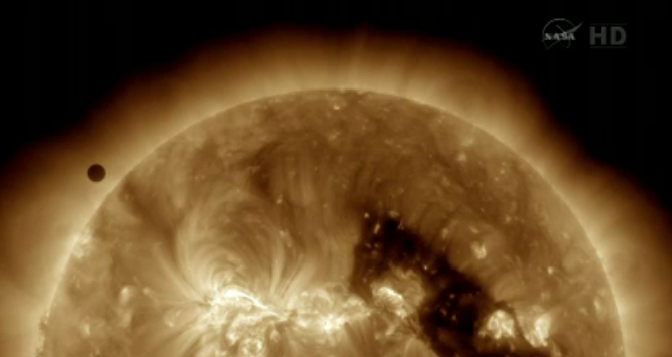
Image Credit: NASA
The first recorded observation of the transit of Venus was made on December 4 (Nov 24 Julian calendar), 1639 in Much Hoole, Lancashire, England. Jeremiah Horrocks and William Crabtree were the only two people to observe and record the event. Venus in sole visa was Horrocks’ treatise and proof of his observation.
Unfortunately, the two friends both died within five years of making their observations. They recorded the occurrence in their own homes and it’s not known for sure if they ever met in person. They also accurately predicted the next transit of Venus on June 8, 2004.
The two shared interest in the work of Johannes Kepler, and both were members of a distinguished group of astronomers from the north of England, called “Nos Keplari”, which also included William Gascoigne.
Crabtree was a mathematician, and his calculations played a crucial role in assisting Horrocks to estimate the size of Venus and the distance from the Earth to the Sun. Crabtree only saw the transit of Venus for a short time, due to cloudy weather in his area.
Horrocks, Crabtree, and Gascoigne are considered the founding fathers of British research astronomy. William Gascoigne invented the micrometer, which was used in a telescope to measure angular distances between stars and the relative sizes of celestial objects.
Jeremiah Horrocks made his observation of the transit of Venus at the Carr House, the home of the Stone Family, which was built by Thomas Stone in 1613.
An inscription in raised letters on the stone head of the doorway reads: Thomas Stones of London haberdasher and Andrewe Stones of Amsterdam merchant hath builded this howse of their owne charges and giveth the same unto their brother John Stones: Ano domni 1613. Laus.
Horrocks can also be credited for being the first to demonstrate that the Moon moves in an elliptical path around the Earth. He wrote a treatise on Keplerian astronomy and began to explore mathematically the properties of gravity. Isaac Newton acknowledged his work in the Principia.
The transit of Venus transpired on the 5th and 6th in June of 2012, and the observation by Jeremiah Horrocks was celebrated at St. Michael’s Church in Much Hoole. Horrocks was a curate at St. Michael’s.
The live feed of NASA from Mauna Kea, Hawaii was projected at St. Michael’s and it was streamed around the world. Millions of viewers were able to appreciate what would have been impossible for the common observer in the past. In the closing remarks we humbly offer reference from the astronomer Jeremiah Horrocks:
When the time of the observation approached, I retired to my apartment, and having closed the windows against the light, I directed my telescope, previously adjusted to a focus, through the aperture towards the Sun and received his rays at right angles upon the paper… I watched carefully on the 24th from sunrise to nine o’clock, and from a little before ten until noon, and at one in the afternoon, being called away in the intervals by business of the highest importance which, for these ornamental pursuits, I could not with propriety neglect… About fifteen minutes past three in the afternoon, when I was again at liberty to continue my labours, the clouds, as if by divine interposition, were entirely dispersed… I then beheld a most agreeable spectacle, the object of my sanguine wishes, a spot of unusual magnitude and of a perfectly circular shape, which had already fully entered upon the Sun’s disk on the left… Not doubting that this was really the shadow of the planet, I immediately applied myself sedulously to observe it… although Venus continued on the disk for several hours, she was not visible to me longer than half-an-hour, on account of [the Sun] so quickly setting… The inclination was the only point upon which I failed to attain the utmost precision; for, owing to the rapid motion of the Sun, it was difficult to observe with certainty to a single degree… But all the rest is sufficiently accurate, and as exact as I could desire. — Jeremiah Horrocks
Subscribe Now!
Featured Deal ➸
Social Button ➸
Categories
- ! Без рубрики
- 1
- 7Slots
- a16z generative ai
- Amateur Radio
- antikaeltehilfe.de
- bauhutte-g.com
- blog
- Casino
- chefi.gr
- Cryptocurrency exchange
- extension-autoroutes-non.ch
- Forex Trading
- Future Tech
- Geeky Tips
- Going Green
- Going Mobile
- hundemesse-norderstedt.de
- kinbet-casino.at
- kinbet.at
- mireillelebel.de
- News
- Pin-Up AZ
- Pin-Up indir
- Pin-Up oyunu
- Pin-UP VCH
- Post
- Product Reviews
- ready_text
- s
- s1
- Scanner Listening
- Science Sightings
- Sober living
- Technology
- thomas-petandfamily.de
- Uncategorized
- Новости Форекс
Archives
SQUIDBOARD
Academic Tech
Multimedia MegloMania
Tech Toolbox
- Acronis
- AN/GRC-9
- Apple Final Cut Pro
- Audacity
- Audacity VST Plug-ins
- BleachBit
- ClimateViewer 3D
- Cool Edit Pro 3.1
- CyberGhost
- Flickr
- FreeSCAN
- fring
- Fruper
- FTA Lists
- GPS Calculator
- GPS Converter
- HAMSOFT
- HF Antennas
- inSSIDer
- Levelator
- MaxMind
- Microphone Cables
- Morse Code Chart
- Old Version
- Pendriveapps.com
- PortableApps.com
- Privacy Badger
- PulseAudio
- Rowetel
- ShopJimmy
- Teleprompter Software
- TV Listings
- UNetbootin
- Voicemeeter Banana
- Winlink
RSS feed for comments on this post · TrackBack URI
Leave a reply